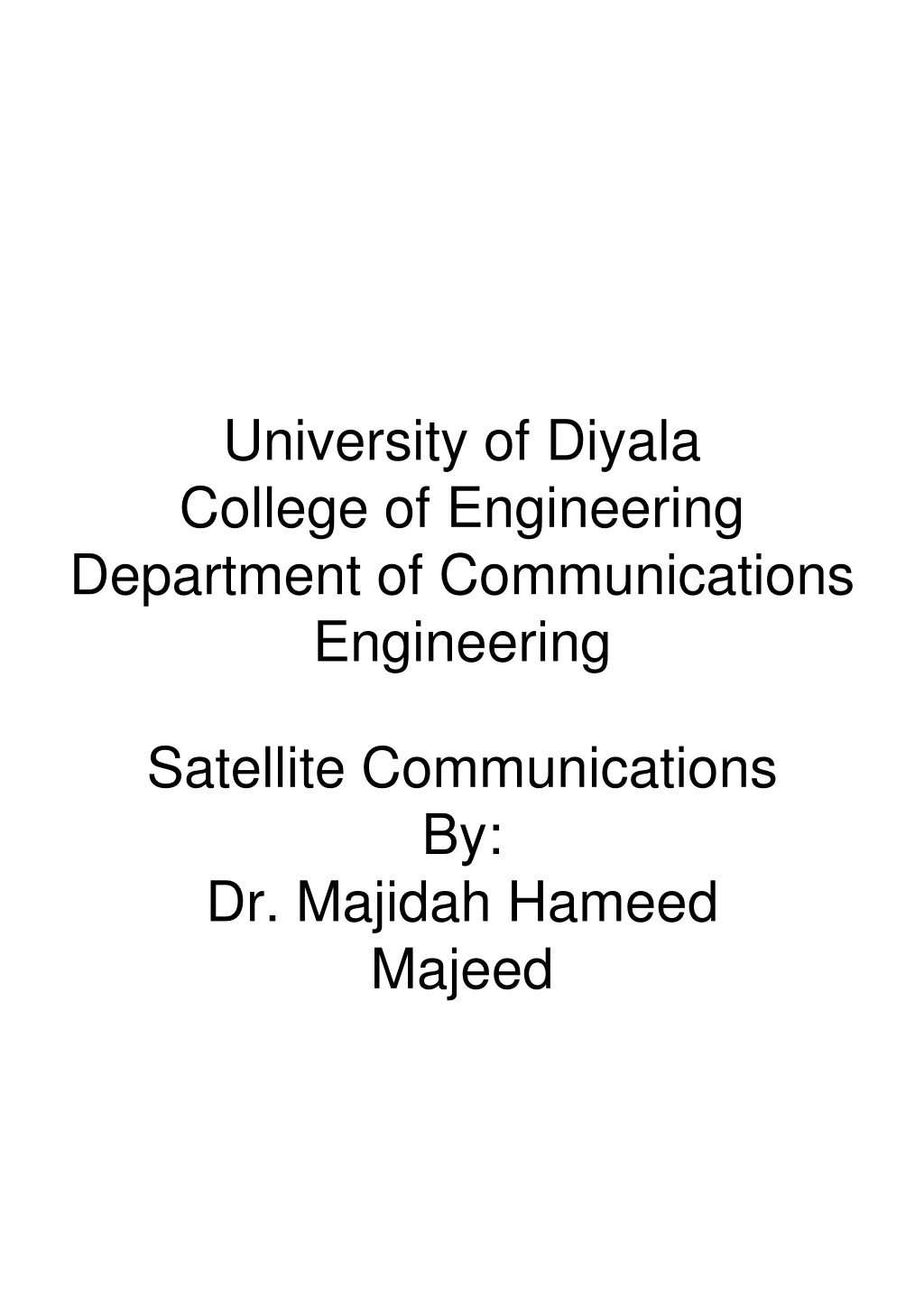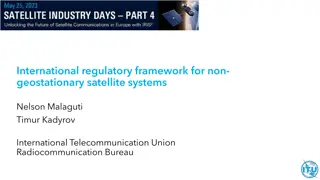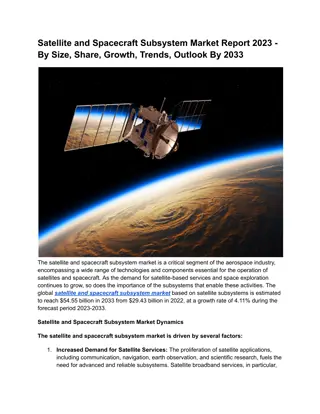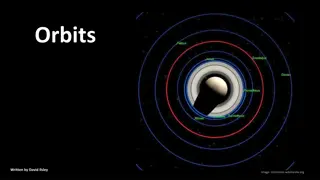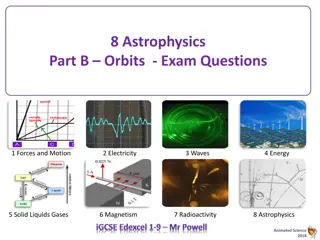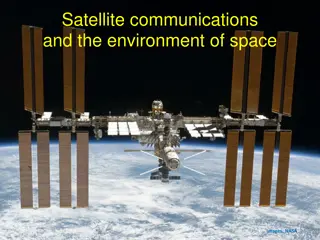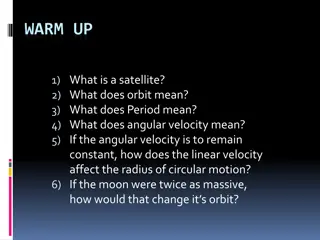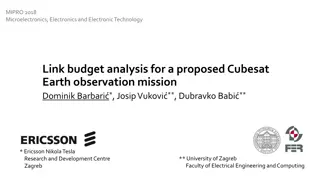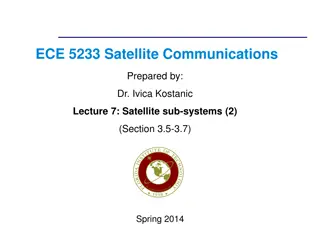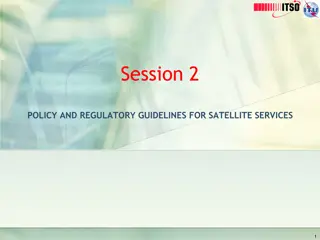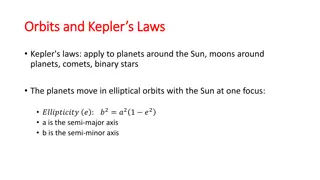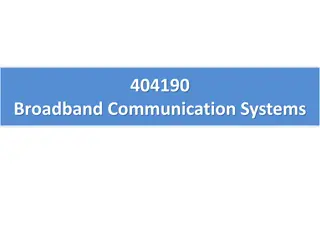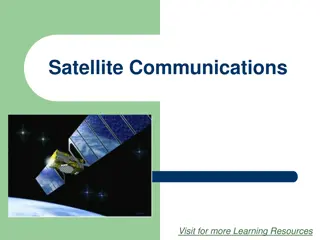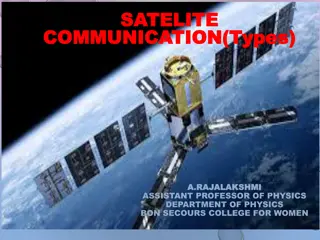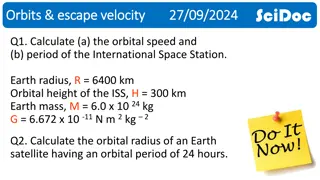Understanding Satellite Communications and Orbits in Engineering
Exploring the intricacies of satellite communications and orbits in engineering, focusing on special types of inclined orbits, circular orbits, elliptic orbits, and the calculation of eccentricity. Examples such as the International Space Station's orbit are used to illustrate concepts. The content delves into key formulas, diagram interpretations, and practical applications within the field of communications engineering.
Download Presentation

Please find below an Image/Link to download the presentation.
The content on the website is provided AS IS for your information and personal use only. It may not be sold, licensed, or shared on other websites without obtaining consent from the author. Download presentation by click this link. If you encounter any issues during the download, it is possible that the publisher has removed the file from their server.
E N D
Presentation Transcript
University of Diyala College of Engineering Department of Communications Engineering Satellite Communications By: Dr. Majidah Hameed Majeed
1.5 Special Types of Inclined Orbits. A satellite orbiting in a plane that coincides with the equatorial plane of the earth is in an EQUATORIAL ORBIT. A satellite orbiting in an inclined orbit with an angle of inclination of 90 degrees or near 90 degrees is in a POLAR ORBIT. As shown in fig 1.8 fig 1.8 1.6 The Elliptic Orbit The only orbit type we will discuss here is the elliptic orbit as shown in fig ( 1.9) . All satellites that orbit around the Earth are in a elliptic orbit. A parabolic and hyperbolic orbit are non-periodic, and hence represent escape orbits, that is, the satellite in these orbits leaves the Earth. The parabolic orbit is the minimum energy escape orbit.
fig 1.9 In the figure we can identify the followingitems: Occupied focus location of the Earth or central attracting body a = semi-major axis r = radius from center of Earth to satellite rp = Earth perigee distance ra = Earth apogee distance e = orbit eccentricity (0<e<1 for elliptic orbits, e = 0 is circular orbit) Note that r is measured from the center of the Earth, hence we can note that: where h = height above Earth s surface, Re = earth radius Often times the perigee and apogee distances are given in terms of the height above the Earth s surface. This is not correct, and the radius of the Earth must be added to the height to get the perigee and apogee radii. The polar equation for the elliptic orbit, with the origin at one focus is given by:
.(1) ... .(2) ..(3) Example The international space station is in a 372 x 381 km orbit , what is the eccentricity of the orbit? Solution: The two numbers refer to the perigee height (372 km) and the apogee height (381 km). However, these are the heights above the Earth s surface and must be converted to perigee and apogee radii by adding the Earth s radius. Hence the international space station is in a near circular orbit. In order to find the apogee and perigee height. The length of the radius vectors at apogee and perigee can be obtained from the geometry of the ellipse:
from equation (2) , Where ra: radius vector at apogee rp: radius vector at perigee e : Eccentricity Then we can calculate haand hpas follow: 1.7 Circular Orbits We stated previously that a circular orbit is a special type of elliptical orbit. It should realize a circular orbit is one in which the major and minor axis distances are equal or approximately equal. Mean height above earth, instead of perigee and apogee, is used in describing a circular orbit. A satellite in a circular orbit at a height of approximately 36000 Km above the earth is in a synchronous orbit. At this altitude the period of rotation of the satellite is 24 hours, the same as the rotation period of the earth. In other words, the orbit of the satellite is in sync with the rotational motion of the earth. Although inclined and polar synchronous orbits are possible, the term synchronous usually refers to a synchronous equatorial orbit. In this type of orbit, satellites appear to hover motionlessly in the sky. Figure 1-8 shows how one of these satellites can provide coverage to almost half the surface of the earth. Figure 1-8 - Illumination from a synchronous satellite.
Three of these satellites can provide coverage over most of the earth (except for the extreme north and south polar regions). A polar projection of the global coverage of a three-satellite system is shown in figure 1-9. Figure 1-9. - Worldwide synchronous satellite system viewed from above the North Pole. 1.8 Kepler's Law: Johann Kepler determined three laws characterizing orbital motion, These laws can be proven mathematically using Newton's law of gravitation. Kepler's laws are paraphrased below along with the corresponding physical implications. These laws apply directly to satellite orbital motion, thus the laws are from the point of view of an Earth-orbiting satellite. Kepler's First Law: Satellite orbits are elliptical Paths with the Earth at one focus of the ellipse Kepler's Second Law: A line between the center of the Earth and the satellite sweeps out equal areas in equal intervals of time.
Kepler's Third Law: The square of the orbital period is proportional to the cube of the the orbit's semi major axis. 9. Elevation angle The angle from the horizontal to the point on the center of the main beam of the antenna when the antenna is pointed directly at the satellite Coverage angle - the measure of the portion of the earth's surface visible to the satellite Reasons affecting minimum elevation angle of earth station s antenna o (>0 ) Buildings, trees, and other terrestrial objects block the line of sight Atmospheric attenuation is greater at low elevation angles Electrical noise generated by the earth's heat near its surface adversely affects reception
Figure 1-10. Elevation angle Orbit Height h CoverageAngle ElevationAngle ?+ ?=???(?+ ?) ? ???(?) Ex : A satellite at a distance of 10000 km from a point on the earths surface , the Coverage Angle = 4 draw and find the Elevation Angle . R= 6378 * ?km 1.10 The ForcesActing on Satellite When a satellite is launched, it is placed in orbit around the Earth. The Earth's gravity holds the satellite in a certain path as it goes around the Earth, and that path is called an "orbit." There are two main forces acting on satellite : a centrifugal force due to the kinetic energy of the satellite, which attempts to fling the satellite into a higher orbit. And a centripetal force due to gravitational attraction of the planet about which satellite is orbiting, which attempts to pull the satellite down forward the planet. If these two forces are equal, the satellite will remain in stable orbit. The formula for centrifugal force is: Fc = (mv2)/r
The formula for the gravitational force between two bodies of mass M and m Fg= (GMm)/r2 is Where M is the mass of the Earth, m is the mass of the satellite G (Newton's Gravitational Constant, r is the orbital radius v the speed of satellite. For the satellite stable in orbit , Fc= Fg, then (mv2/r) = (GMm)/r2 v2/r = (GM)/r2 Now, v = 2 r /T then (2 r/T)^2 /r = GM /r^2 => (4 2 r)/T2 = (GM)/r2 => r3 = (GMT2)/4 2 We know that T is one day, since this is the period of the Earth. This is 8.64 x 104 seconds. We also know that M is the mass of the Earth, which is 6 x 1024 kg. Lastly, we know that G (Newton's Gravitational Constant) is 6.67 x 10- 11 m3/kg.s2 So we can work out r. r3 = 7.57 x 1022 Therefore, r = 4.23 x 107 = 42,300 km. So the orbital radius required for a geostationary, or geosynchronous orbit is 42,300km. Since the radius of the Earth is 6378 km the height of the geostationary
orbit above the Earth's surface is ~36000 km. Fig 1.11 Gravitational force is inversely proportional to the square of the distance between the centers of gravity of the satellite and the planet the satellite is orbiting, in this case the earth. The gravitational force inward (FIN, the centripetal force = Fc) is directed toward the center of gravity of the earth. The kinetic energy of the satellite (FOUT, the centrifugal force= Fg) is directed opposite to the gravitational force. Kinetic energy is proportional to the square of the velocity of the satellite. When these inward and outward forces are balanced, the satellite moves around the earth in a free fall trajectory: the satellite s orbit.
Fig 1.12 The forces acting on satellite 1.11 Orbital Velocity The velocity required to maintain a satellite at the orbit radius r can be calculated as follow:- Depending on the laws of motion first developed by Kepler and Newton. The competing forces act on the satellite; gravity tends to pull the satellite in towards the earth, while its orbital velocity tends to pull the satellite away from the earth, as in 1.13 The gravitational force, Fin, and the angular velocity force, Fout, can be represented as: For the satellite stable in orbit , Fc( Fin ) = Fg (Fo), then (mv2/ =(GMm)/r2 v2/r = (GM)/r2 Where v : satellite velocity for circular orbit in km/sec
Figure 1.13 Forces acting on a satellite Note that for the discussion above all other forces acting on the satellite, such as the gravity forces from the moon, sun, and other bodies, is neglected. Example Human-made satellites typically orbit at heights of 400 miles from the surface of the Earth (about 640 kilometers, or 6.4 105meters). What s the speed of such a satellite?All you have to do is put in the numbers: This converts to about 16,800 miles per hour. 1.12 Launching Satellites into Orbit. Placing a satellite into geosynchronous orbit requires an enormous amount of energy. The launch process can be divided into two phases: the launch phase and the orbit injection phase. The Launch Phase During the launch phase, the launch vehicle places the satellite into the transfer orbit--an eliptical orbit that has at its farthest point from earth (apogee) the
geosynchronous elevation of 22,238 miles and at its nearest point (perigee) an elevation of usually not less than 100 miles as shown below in Figure 1-14. The Orbit Injection Phase The energy required to move the satellite from the elliptical transfer orbit into the geosynchronous orbit is supplied by the satellite s apogee kick motor (AKM). This is known as the orbit injection phase. Figure 1-14: The EllipticalTransfer Orbit Ageostationary orbit is an orbit in which a spacecraft can appear to hover over a fixed point on Earth. That is particularly useful for communication or observation satellites. This is a little different than a geosynchronous orbit, which is one in which a spacecraft will pass over the same point, once per day. So, if we want our spacecraft to appear to hover over a fixed point on Earth, two criteria must be met. The first is that the orbit must be equatorial (inclination of 0 degrees) and the second that the angular velocity must match that of the surface of the Earth. That turns out to be around 35,900 km (22,300 miles). That gives us two challenges to solve. The first is that we need to get to that high
altitude and the second is that we likely need to change our inclination . Figure 1-15 Depending on the mission and launch vehicle, one of two things happens first. The rocket often takes the spacecraft to a parking orbit at an altitude of 180-200 km , this called the parking orbit , but it can sometimes skip the parking orbit and go straight to what is called a geostationary transfer orbit. Parking orbits are often used to test vehicle systems before committing to further action. Figure 1-16
The GeostationaryTransfer Orbit (GTO) is a highly elliptical orbit with a perigee of 180-200 km above the Earth's surface and an apogee of around 35,900 km. The spacecraft has an engine that is called theApogee Kick Motor (AKM). That motor is fired at apogee to circularize the orbit. But it usually is not all done at once. Usually theAKM is used three times. Figure 1-17 Each of these burns has two objectives: 1) increase the perigee of the orbit and 2) decrease the inclination of the orbit. 1.13 SiderealTime Vs SolarTime Sidereal Time: is a time scale that is based on the Earth's rate of rotation measured relative to the fixed stars. Sidereal day = 23h 56 m 04.09053 s Solar Time: is a reckoning of the passage of time based on the Sun's position in the sky. Solar day = 24 h Satellite orbits coordinates are specified in sidereal time rather than in solar time. Solartime, which forms the basis of all global time standards.
The earth rotates once per sidereal day of The earth rotates once per sidereal day of 23 h 56 min 4.09s. Use 23 h 56 min 4.09s. 1.14 Footprint: The area on Earth that the satellite can 'see' (or reach with its antennas) is called the satellite 'footprint'.Asatellite's footprint refers to the area over which the satellite operates: the intersection of a satellite antenna transmission pattern and the surface of the Earth Figure 1-18
